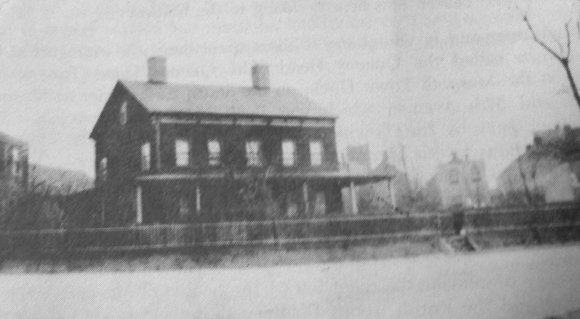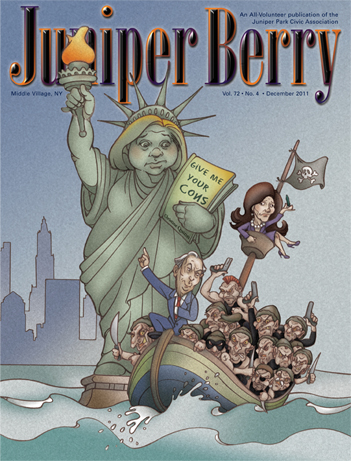During the Revolutionary War, Newtown Township lay in the hands of the British, and while it is contrary to say so, most of the Newtown folk were Tory in sympathy, if not in actual action. It is not often taught in our schools that so many of the early Americans were appalled at the idea of Independence from their mother country, England. After all, they were, firstly, Englishmen and while they were being much abused by the English Colonial Policy which kept them from doing their own manufacturing, and which bled the colonies of raw materials while taxing them abominably, the colonists here still considered themselves English, and hoped only for a fair representation at home in England, and the relaxation of the harsh taxes. It was therefore, not so surprising when a small band of what today we would call anarchists, began to incite the colonists to rebellion against their accepted ruler, King George, and to meet in unruly bands comprised in great part of the ragged edge of society, the unemployed and uneducated, that the main body of colonists looked upon the Independence movement, at first, as a dangerous idea conceived by a dangerous rabble.
Here in the Newtown Township, the Battle of Long Island occurred on August 27, 1776 and brought about the immediate occupation of the area by British soldiers. General William Howe (pictured on opposite page), commander in chief of the British forces, entered what is now Elmhurst and took up a headquarters in the Samuel Renne house on Queens Boulevard just opposite Macy’s. Behind the Renne House on the hills near St. Adalbert’s Church, were the tents of legions of British Red Coats, throughout the occupation. In Elmhurst Village, were camped the troops of Lord Percy and General Grant.
At Maspeth, near the Newtown Creek were the light infantry under Brigadier General Leslie the British Reserve under Lieutenant General Earl Cornwallis, and General Vaughan, who made their headquarters in the old Alsop Mansion. In the same location were quartered the dreaded mercenaries the Hessian grenadiers and chasseurs under Colonel Donop. The entire lot of these being under command of Lieutenant General Sir Henry Clinton who had his headquarters in the Moore house which stood along Bowery Bay Road, a little to the North of Jackson Avenue, in what was called North Woodside, at one time.
Owing to the circumstances described earlier, the Tory inhabitants of Newtown were the majority and, just as soon as the British had shown their supremacy at the beginning of the War, these Tories turned violently against their Whig neighbors and spied upon them, refused to buy and sell trade items, did damages to their lands and farms, and, in one instance Dr. Moore led a group of young Tories to cut off the steeple of the Presbyterian Church in Elmhurst, because that group of people said that they stood for Independence.
Distinctive among the cruelties of the Newtown Tories towards their neighbors was that of George Rapelje, who lived along the Calamus Road, (the house has gone long since but it stood near the Long Island Railroad tracks). This British sympathizer did all he could to persecute his American neighbors and to aid the British, so that he even became a paymaster to the English troops, and when assessments were laid upon the townspeople to provide food for the British soldiers, George Rapelje was appointed to collect these, and he did so with great pleasure, cheating many of his neighbors so greatly that he and his wife Polly had to flee Newtown after the War, and never returned here.
The town was divided into two sections during the war, the North and the South beats. In these areas, once the British had taken them, it was necessary for the town men to form a British militia, after talking the Oath of Loyalty, (to the King), and fight against their brother Americans, or Rebels.
This discussion of Tories is not to preclude the fact that at the beginning of the Revolution, before the British took Long Island, there were many men who formed regiments on the American side. The Newtown men who were originally for the American Patriots in the North Beat were 107 in number and the officers were Jonathan Lawrence, William Sackett, William Lawrence, Jesse Warner. In the South Beat there were 86 Patriots, and they were led by: Abraham Remsen, Benjamin Coe, Robert Furman, and Benjamin North, but, in order to live among their neighbors after the British triumph on Long Island, some of these these men to all outward appearances, became Tory Sympathizers also, rather than go into exile, as did many who were patriots.
In Maspeth, the Sackett House later DeWitt Clinton’s, which stood right at the head of Maspeth Creek, was the headquarters of General Warren, from which place he supervised the debarking of his troops into ships for the taking of Kip’s Bay, New York. The British gentlemen who were British officers liked their comfort, as is the case with all generals, and one finds, in perusing old records of the Revolution, that almost every fine old house in Newtown was appropriated as the headquarters for some British officer. Persons whose homes were confiscated in this manner had by far the best of the bargain compared with their less fortunate neighbors upon whom may have been quartered as many as twenty British Regulars, to be fed and given the best fire in the house. In homes where the Hessians were quartered, their habits being unclean, a dreadful fever took root, which was to recur in the hot summer months for several years after the Revolution was over, killing many residents.
Some roads over which the British troops marched during the occupation of Long Island from 1776 to 1783, were the Calamus Road as it led from Maspeth Creek, (English Kills), to Newtown Village, (Elmhurst).
Others were: Maspeth Avenue as it passed the Quaker Meeting House on the site of the present St. Stanislaus R.C Church; Flushing Avenue which was called the Ferry Road, as it led down to the crossing where a ferryman would row travelers to Brooklyn, Rust Street which went to the same place; and Fresh Pond Road, which in Colonial times ran along the present course of 61 Street, or old Clermont Avenue, (the present Fresh Pond Road is recent). Grand Avenue, Betts Avenue (58th Street), and Old Brook School Road, (59th Place), were cart paths during the Revolution. Grand Avenue led to Newtown Village, and 58th Street and 59th Place led to Long Island City.
On September 3, 1783, a definitive treaty of peace was signed in Paris, which concluded the seven years British occupation of Long Island. Newtown township began to look around at the devastation caused by so many years of hostile predators camping within her bounds, and saw that the woodlands were almost totally stripped from the earth, due to the cutting of timber for fires and fence, by the British.
It was time for the wrongs of the Tories against the patriotic American residents of Newtown to be punished, and as the British troops withdrew the last of their forces from the town, Tories who had acted as spies against their neighbors, or brought trouble upon the Patriots were tossed from their homes. They fled before the wrath of Americans and went as fast as they could to Nova Scotia, where the British Crown had provided a refuge for them, and a place of exile.
Our Town and the American Revolution (sidebar)
Newtown Creek & Maspeth Landing:
It was the route by which European colonists first reached Maspeth. During the American Revolution, the British hid their ships in the waterway to protect them from attack by the American army. Farmers brought their produce to the Maspeth Town dock on the way to Manhattan. During the Revolutionary War it became a landing place for British supplies and was one of the strategic British Headquarters for the duration of the war. They used the Queens Head Tavern (pictured below). It was located near what today is the Clinton Diner.
On August 29th Major-General Robertson and a portion of the British Army came marching up the Ferry Road from Brooklyn, cut over to Maspeth Avenue, passing the Quaker Meeting House (now St. Stanislaus R.C. Church) and continued along Grand Avenue. They drove before them an enormous herd of cattle which they had confiscated on their way from Brooklyn and which they planned to corral at Newtown Village. While fetching water within the Village, the soldiers committed certain hostile acts upon the villagers. Their behavior caused Gen. Robertson to write an apology to the people of Newtown Village, although pillaging and looting of local homes continued for severn years of the British occupation.
On September 15, 1776, General Lord Howe decided to attack Manhattan Island. He ordered three Ships of War to sail up the North River and get the American’s attention while he launched his entire First Division in flatboats against Kips Bay. The flatboats were embarked from the head of Newtown Creek as General Lord Howe and General Warren watched from the Sackett-Clinton House (later Gov. DeWitt Clinton’s mansion) in Maspeth. The Americans on Manhattan Island under General George Washington made their retreat to Harlem and escaped the British attack.
Maspeth was a small community near the Creek whose major importance during Colonial times was its Town Dock. During the Revolutionary War Maspeth had only 12 houses. There was little increase until about 1800.
Juniper Valley Park: The park's history can be traced all the way back to 1776 during the American Revolutionary War. During that time the park was known as the Juniper Swamp and it was a strategic location during the war's Battle of Long Island. American soldiers used the park as a place to hide when British troops invaded New York City and Long Island. Once the British found the swamp, they then used the swamp to camp out, cut down the white cedar trees and burned peat from the bog to keep warm.




